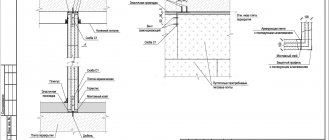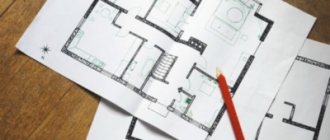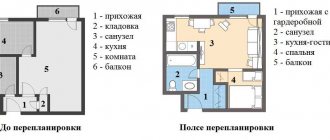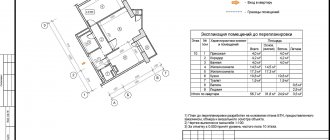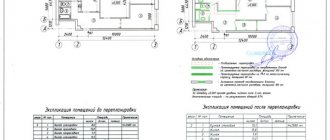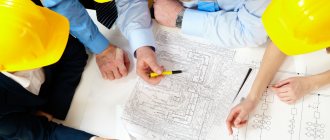Redevelopment of an apartment according to an agreed project
Redevelopment is a change in the location and size of rooms and other premises in an apartment in accordance with the needs of residents. It is carried out in a number of cases:
- The rooms are poorly shaped.
- The size of the rooms does not meet the needs of the family.
- It is necessary to combine two apartments into one.
- It is necessary to divide the apartment into two.
In these cases, there is a need to change the shape and location of the walls, create new rooms or, conversely, combine existing ones into a single space. Regardless of intentions, redevelopment should be carried out taking into account the distribution of loads on the walls. This problem should always be taken seriously, especially if we are talking about a multi-story building.
The fact is that in multi-storey buildings the walls of rooms are often load-bearing. If the integrity of such a wall is damaged, the distribution of loads on the walls throughout the house is disrupted. That is why it is important to determine which walls are load-bearing and which are internal partitions.
Most often, a decrease in the strength of a structure does not immediately lead to any critical damage. But if redevelopment is carried out in many apartments, the violation of integrity becomes more and more serious and, over time, reduces the strength of the house’s structure.
And even with minor external influences, such as a small earthquake, this can lead to the collapse of the structure.
Critical violations of strength can lead to destruction even without any external influences. Especially if improper redevelopment is carried out on the lower floors of the building. There are many cases where apartments on the first floors were converted into shops by removing the walls between the rooms. It is precisely this kind of illegal redevelopment that can lead to the destruction of the house.
Therefore, if you need to remodel your apartment, you should contact those who can calculate and carry out safe changes.
The most effective solution would be to cooperate with specialized architectural and construction companies that specialize in apartment redevelopment projects, collecting the necessary documentation for their approval, and carrying out safe redevelopment work.
Currently, the country has a huge number of illegally redesigned apartments that were rebuilt without projects with special calculations. Therefore, we can assume that the housing stock has been largely damaged by such activities of hapless property owners and is in critical condition due to violations of the integrity of the structures.
Bearing wall
Independent apartment redevelopment
Changing the location and configuration of residential and technical premises in housing is defined as redevelopment of an apartment in a panel house.
In order to officially legitimize the redevelopment of an apartment, permission is required from municipal authorities dealing with housing and communal services, BTI, and other organizations, with the changes made being entered into the technical passport of the living space. The functional purpose of the interior premises and rooms does not change; the usable area is undergoing reconstruction, which increases (for example, combining a room with a kitchen area), decreases (an additional toilet), at the request of the owner, according to his vision of what the interior of a modern home should look like.
According to the law of the Russian Federation of 2021, any alteration or redevelopment of premises requires permission or approval from municipal authorities.
Problems arise due to the owners’ misunderstanding of the direct definition of redevelopment and other work carried out on the premises to improve the quality of life of a citizen.
Apartment redevelopment, repair work, carried out with different intensity and purpose, are divided into:
- Cosmetic. Minor work on finishing the walls, floors, ceilings of the room, without changing the location of technical, living rooms, reducing (increasing) their area, through installation or dismantling of partitions, load-bearing structures, ceilings, floors, etc. They also include standard installation, dismantling of technological equipment for the purpose of replacement, installation, reconstruction of built-in furniture. No permissions from government regulatory authorities are required.
- Medium difficulty. Repair and reconstruction of old partitions, walls, installation of new ones in their place, without changing the design location. Includes laying window and door openings, installing new technological equipment, and dismantling it, without changing the location of the main risers. Coordination with the relevant municipal services for independent reconstruction is required.
- Capital, complex. Reconstruction, redevelopment of premises affecting important load-bearing structures, floors, ceilings, with possible negative consequences. Mandatory obtaining permission to carry out the necessary work from authorized municipal bodies. Issued based on the results of approval and inspection, before the start of work and after completion, respectively.
- Strictly prohibited. All work is prohibited by the legislation of the Russian Federation. In the case of the latter, it is not possible to legitimize such changes in any way. During privatization, sale, exchange, or other commercial transactions, problems await the owner, and the value of the property will be different.
Features of legislation
Taking into account all possible risks and loads on the structure, strict requirements have now been developed regarding which redevelopments are permissible and which are strictly prohibited in accordance with the Housing Code.
- First of all, it is prohibited to destroy load-bearing (main) walls, as well as to violate their integrity without compensating for strength. Indeed, in this case, the destruction of load-bearing walls will negatively affect the strength of the house structure and can lead to emergency situations. In many apartments, especially old buildings from Soviet times, partitions between rooms are load-bearing. Therefore, independent redevelopment of a Khrushchev building or expansion of rooms can be a big problem.
- The next ban is moving bathrooms and toilets. It is against the law to place bathtubs, showers and toilets above kitchens and living areas. Also, in no case should you expand the area of the bathroom or toilet at the expense of the corridor between them, since such a move will require the transfer of all communications, displacement of sewerage and water supply pipes. This can lead to disruption of ventilation, sewerage and many other systems throughout the house.
- Very stringent requirements are established for the premises to which gas is supplied. It is prohibited to change the configuration of such premises, to connect the kitchen to the room and to create any openings in the walls. Moreover, even the number of burners for a certain kitchen area is regulated. This is due to combustion products that are released when the burners operate. It is important to establish the quantity at which the safety of using the burners is guaranteed. For example, in small kitchens, such as in Khrushchev-era buildings, it is prohibited to install stoves with more than three burners.
- It is prohibited to combine a room or kitchen with a balcony if the external walls are load-bearing. Placing water heating radiators on the balcony is not allowed due to the risk of them freezing and disrupting the heat supply to the entire house.
- Another, albeit rather strange and controversial, ban is the ban on creating a room without a source of natural light, that is, without a window. For example, you cannot design a study in the back of one of the rooms.
Important to know! It is impossible to coordinate or legalize redevelopment through the court if we are talking about the above-mentioned interventions in the structure.
Room configuration
A number of other redevelopment options can sometimes be legalized through the courts. Often the court performs the functions of the authorities that are responsible for the development and execution of redevelopment, and issues a decision in each specific case. Minor redevelopments that can be legalized in court include:
- Changing the structure of partitions.
- Installation of additional doors in partitions.
- Other minor changes that do not compromise the integrity of the structure.
Let's figure out how to legalize the redevelopment of an apartment if the reconstruction has already been carried out without documents permitting such work. This can only be done by collecting the entire package of documents and enlisting the conclusions of experts.
Illegal redevelopment entails severe sanctions - from large monetary fines to forced sale of the apartment at auction.
A person who has carried out work to change the design of a room without proper permission becomes a hostage to the situation. He cannot sell his apartment and is constantly under threat of sanctions. In addition, he may be required to restore the apartment to the condition it was in before the work was carried out.
Young couple studying documents for redevelopment
How to legalize redevelopment correctly?
How and where to legalize the redevelopment of an apartment correctly? In order to properly coordinate and obtain legal permission to remodel an apartment, you must:
- Provide documents to the municipal authorities: an application for carrying out the relevant work, a technical passport of the residential premises, a project for the changes being carried out, a certificate confirming the rights to the living space, an act on the non-belonging of the structure to legally protected knowledge with a note on the permissibility of changes.
- Obtain permission to carry out reconstruction work. Issued by the municipality according to general standards within one and a half to two months from the date of acceptance of the documentation. Upon receipt of the permit, it is recommended to begin the agreed construction and repair work.
- Upon completion of the redevelopment, carry out an inventory of the housing by BTI employees, drawing up an official certificate of compliance of the work performed with the design approved. Upon signing the act, new documents are issued after ten calendar days.
- Obtain an official order from the municipal authorities to preserve the premises in a new form.
- Enter the new project plan into the technical passport of the living space in the BTI regulatory authorities in two copies (actual, electronic version).
- Issue a cadastral passport for the renovated housing. Received from the cadastral service no later than thirty days later.
- Obtain a certificate of ownership of the property. Submit all of the above documents to the main department of the relevant cadastre service.
The best protection is approval of redevelopment
Prohibition of uncoordinated redevelopment is a necessary measure to ensure the safety of buildings. Therefore, all violations during redevelopment will be prosecuted in accordance with the law. An illegally redeveloped apartment cannot be sold, bought, and even difficult to officially rent out.
In view of this, if it is necessary to remodel a home or office, the most reliable way would be to coordinate the redevelopment of the apartment. To do this, you need to contact a company that specializes in the development of redevelopment projects and works with government agencies to coordinate all the documentation for such construction.
This is the most convenient and safe option, since the redevelopment project is developed by professionals.
Such specialists have all the necessary knowledge regarding risks, ways to ensure safety during reconstruction and the nuances of legislation. In addition, contacting these organizations significantly simplifies the entire process, since the customer does not require any effort in collecting documents and visiting a number of authorities.
The entire package of documents is fully prepared by the development company.
Full list of documents for obtaining permission for redevelopment:
- Title documents for the apartment.
- Apartment registration certificate.
- Floor plan of the house.
- Explication before and after redevelopment.
- Conclusion of Rospotrebnadzor.
- Conclusion of the sanitary and epidemiological station.
- Conclusion of the architectural planning department.
- Fire inspection report.
You may also need:
- Agreement with the design organization.
- Redevelopment project.
This is a complete package of documents that allow you to legally begin redevelopment. If it is carried out without prior approval, such a package will be needed in order to legitimize it.
Let's look at how to legalize redevelopment that has already been carried out. Please note that this is much more difficult to do than obtaining permission for redevelopment. To do this, you need to collect all the listed documents, starting from the technical passport of the apartment and the floor plan of the house to documents on ownership.
Then you should contact the municipal authorities to obtain legal confirmation of the alteration. If this fails, you will have to go to court.
Court decisions are not always positive. Often even minor changes are considered illegal. They are required to pay a fine and/or eliminate them.
It should be noted that redevelopment without approval is a significant problem when selling an apartment. The owner must legalize all changes to the design, since, otherwise, the responsibility for the redevelopment will be transferred to the buyer. In this situation, the price of the apartment decreases significantly.
A worker studies an apartment redevelopment project
What is needed to legalize unauthorized conversion or redevelopment in an apartment building?
The fastest and easiest way is to go to court. Firstly, most often Star-Service clients complete the work first, and only then think about legal issues. Secondly, even if you were unable to agree on the redevelopment in the manner prescribed by law before starting work, you can always appeal the decisions of the Architectural Department of your area. The received court permission can either provide an opportunity for repairs with redevelopment, or oblige the registrar to make all the specified changes to the technical passport.
A few important points:
- 1) The more extensive the work was carried out, the more difficult the process of agreeing on all changes will be;
- 2) The court decision may be different, depending on the situation, up to the mandatory restoration of the original configuration of the apartment at the expense of the applicant (owner of the apartment);
- 3) Until you have approved the redevelopment, you cannot fully dispose of your apartment (sell, donate, exchange, use as collateral).
To submit materials to the court, you will need:
- Provide a technical, cadastral passport, documents confirming ownership;
- Written conclusion of the Sanitary and Epidemiological Station;
- Redevelopment project (if any) from a licensed company;
- A decision refusing to make changes to the layout from the architectural department of your district administration (at the location of the property);
- Conclusion on fire safety from the Ministry of Emergency Situations;
- Receipt for payment of state duty;
- Passport;
- If the principal applies, then a notarized power of attorney and a passport;
- If there are several owners, an application from all is required;
- Statement on behalf of the owner.
In this case, the court considers the issue based on an application for changes to the layout or an appeal against the decision of the Cadastral Chamber. Moreover, you can apply to the courts sequentially with two applications at once, which creates more opportunities for owners of apartments with redevelopment. An extract from the Unified State Register of Real Estate Rights is provided as title documents. It is noteworthy that to confirm the actual condition of the property, the Cadastral Chamber sends a specialist who compares the information in the technical passport with the configuration of the property, and this service is paid. You can check the current cost at the territorial office of the Cadastral Chamber in your area.
In what cases is it recommended to coordinate redevelopment with BTI before starting work?
- Work with gas equipment;
- Working with floors;
- Installation of stairs, construction on upper floors with passage of floors;
- Work on the facade of a building, which can significantly change the appearance of the object;
- Work that may affect the interests of third parties (neighbors, utilities, management company);
- Work with load-bearing structures (walls, beams, supports);
- Installation of heavy equipment.
In these cases, even with the participation of professional lawyers, conditions at the site can entail significant risks for the owners. Starting from compensation for damage caused as a result of redevelopment, ending with the risk of collapse or deformation of supporting structures.
How are applications processed by the architectural department during redevelopment?
After submitting your application and the necessary package of documents for approval of the redevelopment sketch, the architectural department reviews it within a month. In some areas, changes are envisaged in the procedure for submitting documents for approval of redevelopment, for example, you need permission from neighbors, the management company, a certificate or an extract. In order for your application to be considered faster, it is better to immediately clarify the list of required documents with the architectural office.
The issue of redevelopment is considered not individually, but by a commission, with an official decision that can be appealed. After receiving permission, you can begin repair, construction or dismantling work. Sometimes, to clarify information, BTI may send specialists who take measurements. Consequently, if they discover the fact of illegal redevelopment, counter-applications may be submitted to the courts.
Choosing a construction company
The next stage after creating a redevelopment project and its approval is choosing a construction company and drawing up an estimate for the work.
It is recommended to choose construction and renovation companies that focus specifically on redevelopment. It would be most reliable to turn to those who have sufficient experience and have also proven themselves well in carrying out work of this nature.
Cooperation with construction and repair companies serves as a kind of guarantee of high-quality repairs and significantly simplifies the process of obtaining documents for an apartment after redevelopment.
Before starting reconstruction, a special estimate is drawn up taking into account the cost of work and materials. The fact is that many companies offer their materials, the prices of which are comparable to average retail prices. At the same time, the company providing its resources guarantees their quality.
If the materials turn out to be substandard and become unusable ahead of time, such a company must compensate for losses and redo poorly performed work. At the same time, she must provide all the necessary materials without charging additional fees to the customer.
In addition to the estimate, it is also advisable to draw up a work schedule taking into account the number of specialists involved. This allows you to control the contractor’s work and organize his team.
It should be borne in mind that the redevelopment of a one-room apartment is usually aimed at increasing free space, and often turns out to be relatively low-cost and quick due to the small volume of work. While the redevelopment of a two-room apartment is an optimization of its structure.
This may require much more complex engineering and design solutions. Such work may require much more time and materials.
Materials for construction work
Redevelopment in new buildings: do's and don'ts
Modern developers offer a large selection of apartments with different layouts. But often buyers have their own idea of what their home should look like.
If you are satisfied with the residential complex and the area of the apartment, but do not like the placement of the rooms and their sizes, then you can decide to remodel. But be prepared for the fact that if you decide to rebuild your home in a new building, you will encounter many difficulties, from obtaining a large number of permits to concluding contracts with contractors who will perform construction work and supervision.
To make your task easier, check out how the processes of remodeling an apartment differ at different stages of home readiness.
Changing the apartment plan during construction
Sometimes developers themselves offer clients to choose the layout of their home. To do this, when creating a house project, several standard layout options are made for some apartments, and the buyer can choose the most suitable option for himself.
On the same area you can get completely different apartments. For example, young couples can choose a spacious studio apartment that is ideal for hosting parties, while families with children can choose a layout with several children's rooms so that all family members have their own space.
This marketing ploy allows you to attract more buyers, so the possibility of choosing a layout must be indicated in the advertisement of the residential complex.
But if the house design does not provide for housing redevelopment, then ordering a non-standard option for placing rooms will be much more difficult. Not all developers agree to this. But it's worth a try. After all, this is the easiest and most profitable way to get the apartment of your dreams. It all depends on whether the developer can be persuaded to make changes to the documentation.
Redevelopment before putting the house into operation
At this stage, it is most difficult to obtain permission to change the layout of the housing. To carry out a redevelopment, you will have to obtain many permits and draw up new estimates, so usually developers do not agree to this. The construction company will have to share with you the hassle of collecting permits and preparing new documentation.
Taking into account all the costs of building materials, this method is the most unprofitable. To start redevelopment in a house that has not been put into operation, you will have to:
- sign an additional agreement with the developer;
- obtain consent from the design organization to develop new documentation;
- obtain all permitting documents from the municipality.
Considering all the difficulties, it is better to start rebuilding the apartment after putting the house into operation.
Making changes after putting the house into operation
To change the position of the walls in the apartment, the owner needs to prepare documents and go through a standard procedure, including:
- conducting a technical inspection of housing to determine the possibility of reconstruction;
- preparation of a future redevelopment project;
- carrying out an examination of the project;
- concluding contracts with contractors to perform work and perform architectural and technical supervision of construction;
- obtaining permission to carry out redevelopment from the architectural and construction inspection;
- execution of construction work;
- obtaining a new registration certificate for the apartment;
- obtaining permission to put housing into operation.
Be prepared for the fact that neighbors have the right to be interested in the details of the redevelopment. Do not forget that construction work must be carried out during the day so that noise does not disturb the residents of the house in the evening and at night.
Buying an apartment with an open plan
If you don’t want to tear down the walls and rebuild them after buying a new apartment, you can buy a home with an open plan.
Such apartments are sold without internal partitions and renovations. But do not give in to the illusion that any modifications can be made to such an apartment without the appropriate permits. In fact, all load-bearing walls, the location and dimensions of the bathroom and kitchen, corridors and rooms have already been included in the apartment plan.
The fact is that there is no legal concept of “open plan”. Therefore, in order to obtain permission to build a house, the developer needs to make an apartment design that shows all the partitions between the rooms.
Having bought an apartment without interior walls, it will be easier to remodel. You will save on dismantling partitions. But in order to expand the bathroom or enlarge the kitchen, you will have to obtain the same permits from the Housing Inspectorate as for remodeling an apartment with completed renovations.
Legalization of redevelopment through the court
If the redevelopment was done before receiving the relevant documents, then it can be legalized through the court. In this case, you need to take the following actions:
- call a BTI engineer to issue a new registration certificate for the apartment. A special stamp on the document will confirm the illegal redevelopment. The engineer must check that the supporting structures remain intact, otherwise they will have to be returned to their place;
- submit an application to the Housing Inspectorate for approval of the redevelopment. If a refusal is issued, you must submit an application to the court. After the court orders an examination of the premises and it is completed, the owner will receive a certificate of the inspection. If violations are discovered, they will have to be eliminated and then an appeal must be filed. As a result, a certificate of absence of violations during the redevelopment of the apartment will be issued.
- order a registration certificate from the BTI on the basis of an act issued by the court. The new passport must be registered with the Housing Inspectorate.
There is a fine for illegal redevelopment in a new building. To avoid penalties, it is better not to start remodeling an apartment without the appropriate permits.
Stages of redevelopment
After receiving all permits, drawing up a project and developing a design, it is time to carry out redevelopment work.
Important to know! The “zero” stage of redevelopment is the complete emptying of the apartment from furniture and all other things, since during the renovation they will interfere with the work and be subject to harmful influences. Constantly moving furniture can cause damage or deformation. Construction companies generally do not provide compensation for such damage.
Further actions to carry out the work can be divided into three main stages. The first stage is moving the partitions and creating holes for new doors or other structural parts. At this stage the following is carried out:
- Dismantling old partitions.
- Cleaning and removal of the resulting debris.
- Installation of new partitions.
- Creation of a cement screed.
- Installation of electrical wiring.
Also, error correction is carried out, namely, the alignment of walls and ceilings. Then, windows and ventilation systems are installed, since they often require the installation of additional communications. If the plan involves changes in the bathroom and toilet area, the floor should be waterproofed and plumbing work carried out.
At the second stage, final electrical and plumbing work is carried out:
- Distribution boxes are installed.
- A bathtub, sink, toilet and other plumbing fixtures are installed.
- After leveling the walls, tiling work is carried out in the designated areas.
At the third stage, all cosmetic work is carried out, thanks to which the apartment takes on a residential appearance:
- Uneven surfaces are finally leveled and puttied.
- Painting work is being carried out.
- The flooring is being laid.
- Wallpaper is glued to the walls.
- Electrical fittings are being installed.
- Doors are being installed.
After this, it is necessary to clean the apartment and further design work related to the placement of furniture and ensuring a comfortable space.
It is recommended to entrust the development of a design project to professional designers. This will allow you to decorate the room in the same style with the maximum level of comfort and ergonomics.
The final stage of redevelopment
How to get a BTI plan in Moscow quickly and with guarantees?
The territorial branch of the technical inventory bureau issues the BTI apartment plan at the address of the house. If, during the registration of the BTI plan, violations, illegal redevelopment, or non-compliance with the primary documentation are discovered, the BTI may collect a fine from the owner, tenant or manager. Moreover, when drawing up a floor plan, the BTI of a house at an address may oblige the owner of the apartments to return the layout to its original form if permitting documents are not provided or the legalization procedure is not completed.
In order to avoid such situations, you should:
- Timely contact regulatory authorities, obtain permits, certificates, and make changes to plans;
- Use the services of professional lawyers and cadastral engineers to coordinate redevelopment with regulatory authorities;
- Do not carry out redevelopment work, replacement of engineering systems and communications.
The Star-Service Cadastre and Registration Center will prepare all the necessary documents and certificates, check the legal purity of the BTI plan of the apartment you want to purchase, and will also represent the interests of its clients in court on property issues.
Sound insulation, waterproofing, fire insulation
When remodeling an apartment, it is very important to follow all safety rules and nuances of insulation technologies. One of the most important installations is maintaining the strength of the main walls. Under no circumstances should the integrity of this structure be compromised. But, if the decision to change the main walls is made when creating the plan, then everything else is the work of the construction company.
We are talking about strict adherence to technologies that guarantee comfort and safety for both apartment residents and neighbors.
First of all, it should be remembered that at the legislative level it is prohibited to destroy the soundproofing layer between floors when creating a screed. Due to excessive noise, this can cause major problems for those living on the floor below. That is why it is necessary to use sound insulation in all cases.
Sound insulation is also necessary when constructing partitions, otherwise even the slightest sounds will be heard in the next room. To create reliable sound insulation, materials are used that dampen sound well. For example, mineral wool with increased noise reduction effect.
It is even more important to ensure good waterproofing. When design changes are made in the bathroom and toilet, the moisture insulation that was originally installed during the construction of the house is disrupted. Therefore, it must be restored in order to avoid leaks not only when water gets on the floor, but also when the plumbing equipment is damaged.
The construction company chooses the waterproofing technology depending on how much the structure of the bathroom, shower or toilet changes, and how thick a layer of insulation is required. So, for example, when installing a swimming pool instead of a bathtub, the waterproofing must be significantly strengthened, while simultaneously taking into account the increased loads on the floors.
The most important thing for the safety of residents is compliance with fire safety measures. Combustible materials used in construction must be separated from the living space by a shield made of non-combustible substances. Unfortunately, it is often impossible to avoid combustible materials, so effective thermal insulation is required.
You should also ensure that all wiring is securely separated from flammable materials by non-combustible gaskets. Over time, wiring becomes less reliable and may, at some point, cause a fire if such action is not taken.
When decorating an apartment, the designer should pay attention to ensure that the materials used are as non-flammable as possible. Since many modern materials melt or burn at high temperatures, releasing toxic substances.
Because of them, a fire or fire can be much more dangerous due to the release of dangerous combustion products. In view of this, it is necessary to abandon flammable and “smoky” materials when creating suspended ceilings, finishing partitions or other design solutions. To reduce flammability, you can also treat them with special materials.
Bathroom waterproofing
Obtaining a mortgage, carrying out redevelopment, checking the developer - all this requires a floor plan of the premises, which can be obtained from the BTI
The floor plan of an object is a graphic representation of all rooms on a separate floor of a building, indicating window and door openings, plumbing areas, load-bearing and other building structures, as well as other parameters important for operation. Most often, an explanation is attached to the floor plan - a table with a list of individual rooms in an apartment or house, their area and purpose.
Both documents are appendices to the technical plan of the facility, but can be ordered and used separately.
The floor plan of the Technical Inventory Bureau (BTI) is necessary to confirm the location of the premises on the floor relative to other apartments, to establish the exact area of the entire facility and individual premises in it, to record the structures that are fundamental for the operation of the building. Thanks to the official plan and explication, it is possible to confirm the data provided by the owner for any real estate transactions.
Thus, the BTI floor plan is required:
— to conduct a transaction with a property, including obtaining a mortgage;
— for registration of property rights;
- to legitimize the redevelopment;
— to change the purpose of real estate, for example, transfer from non-residential to residential or vice versa;
— to check the developer’s compliance with the declared area.
Floor plan of BTI apartment
The most common reason why a BTI plan is requested is to confirm the absence or presence of redevelopment of the premises. According to the Housing Code of the Russian Federation, acceptable and unacceptable changes are defined. In particular, redevelopments that violate the strength of load-bearing structures and impede the operation of engineering systems are not permitted.
Therefore, to coordinate redevelopment, apply for a BTI floor plan, which reflects all the fundamental structures of the room.
The BTI document is a drawing that shows the important elements of the room using symbols:
- walls and partitions, supporting structures are separately marked, which must not be removed or moved;
- balconies or loggias;
- doors and windows;
— gas stoves;
— plumbing objects, such as a toilet.
The plan shows the apartment number, the stamp of the department that issued the document, the date of the last measurement and issue of the document.
The explication indicates the total area of the object, the number of rooms, their purpose, the area of each room, the height of the apartment from floor to ceiling. A separate line indicates the exact division into residential and non-residential area in the room. This document must also indicate the date of the measurements.
It is fundamentally important to know what types of actions and redevelopment are strictly prohibited and cannot be agreed upon in the BTI:
— demolition and movement of load-bearing walls and other work affecting their stability;
- increasing the kitchen or toilet and bathroom at the expense of living quarters; - removal of windows in the kitchen;
- combining a kitchen with a gas stove with a living room;
- transfer of wet areas, that is, places under the sink in the kitchen or in the bathroom with toilet, so that they will be located above or below neighboring living spaces;
— warm floors with heating from general heating;
- connecting a balcony to a room is permissible only in the form of an arch no more than 1 meter wide; - organization of residential premises with an area of less than 8 square meters. m and width less than 2.25 m;
- any redevelopment in houses recognized as unsafe;
— organization of attics;
- modification of attic spaces;
- connection of common premises to the apartment, for example, a corridor;
— demolition or modification of communal batteries and their pipes.
The following redevelopments are possible in agreement with the BTI:
- combining rooms if demolition of load-bearing walls is not required; —
connecting a corridor to a room;
- connection to the kitchen room, if the latter does not have a gas stove;
- expansion of the bathroom or toilet due to the corridor or storage room;
- combination of bathroom and toilet;
— creation of openings and arches in non-load-bearing walls;
— changing pipes while meeting the drain angle requirements;
- glazing of balconies.
In special cases, BTI can coordinate the installation of a fireplace and sauna and openings in load-bearing walls of a certain size. It should be borne in mind that if the redevelopment affects common property and premises, then the consent of all neighbors will be required.
Symbols on the BTI floor plan
All fundamental structures on the plan must be marked with symbols: “Wall”, “Load-bearing wall”, “Window”, “Doorway”, “Entrance door to the apartment”, “Gas stove”, “Toilet”, “Apartment number”, “Symbol of wall type”, etc.
If, at the time of measurement, the appraiser discovered a redevelopment that does not correspond to the previous version of the plan and was not previously approved by the BTI, the new plan will have marks indicating inconsistencies. For example, in Moscow, extra or missing structures on the plan are indicated by red lines.
The floor plan does not reflect furniture, radiators and household appliances, as well as showers, bathtubs and sinks.
How to get a BTI apartment plan
You can order a document from the BTI of your city in two ways. You can come in person to the Bureau office, provide the necessary documents and receive a floor plan. In the same way, you can order a plan from the MFC. Muscovites have the opportunity to order a document online through the mos.ru service.
To order a floor plan, you will need to provide the following documents:
- identification;
— certificate of ownership, if data on your right is not yet in the organization’s database;
— notarized power of attorney, if a representative applies;
— application, if an individual applies (sample application);
— letter of guarantee, if a legal entity is applying (sample letter of guarantee)
After submitting an application to the BTI, you will be given an extract indicating the duration of the service and its cost. The amount of the fee for drawing up a floor plan depends on the area of the property and additional services, such as an appraiser’s visit, inspection, and creation of an electronic copy of the document. The document production period is up to 10 days.
How to make changes to the BTI plan
If you are planning a redevelopment or find that you need to legalize what has already been done, that is, make changes to the BTI floor plan, you need to prepare a number of documents.
First of all, you need to draw up a redevelopment plan and obtain technical permission. Next, the property will be inspected by the selection committee and a certificate of completed reconstruction will be issued.
After this, you will be given updated BTI plans, which will reflect all the innovations. If during redevelopment the total area of the premises has changed, then this information may need to be included in the certificate of ownership.
Installation of new partitions: types and materials
As a rule, the basis of redevelopment is the construction of new partitions after dismantling the old ones. Let's look at which partitions are worth stopping at.
Pay attention to the capital partition, which is erected from brick or aerated concrete. Such partitions are made “to last forever,” that is, they cannot be quickly dismantled during subsequent redevelopments. However, they should not be used if the thickness of the floors does not correspond to such loads.
The possibility of their installation will be determined by specialists who are developing the apartment redevelopment project.
The possibilities for constructing lightweight partitions are much wider. They are made using frame technology and are soundproofed. They provide no less effective division of space than heavy ones. At the same time, partitions of this type do not create additional weight loads that are unacceptable in this architectural structure.
Lightweight partitions are made of wood or some modern materials. To ensure sound insulation, a sheathing of two layers of gypsum plasterboard is used on each side, between which mineral wool with increased sound insulation properties is placed.
Capital partitions made of heavy materials are recommended to be used if very effective waterproofing is required, and also to fence off rooms such as a bathroom, toilet, kitchen (if it is separated). This is necessary in order to ensure maximum moisture resistance of the partition and create reliable insulation.
When producing bathroom partitions, it is better to use the following materials:
- Brick.
- Concrete.
- Glass concrete.
- Foam concrete.
It is not advisable to use aerated concrete in bathrooms, since it easily absorbs moisture and contributes to dampening of the entire room. It can only be used for very strong moisture-proof cladding.
In some cases, glass blocks are also used - in rooms such as corridors near stairs (if we are talking about two-level apartments) or in halls at the back of the apartment.
Work with main walls requires special care. It is possible to make holes in them, but strengthening the structure is required. You should also install additional crossbars, or strengthen the opening with pylons or columns. Any decision when designing changes to the design of a room is made only after architectural calculations.
Demolition of partition
Buying an apartment with illegal redevelopment
First of all, you should make sure what kind of redevelopment was carried out. You can accurately determine the nature of the reconstruction using the floor plan and explication (name and area of the premises) of the apartment provided by the seller.
For typical panel high-rise buildings, identifying redevelopment solutions is not difficult. Another thing is modern “monoliths” with an individual (i.e., any possible) layout, especially with an original design. You can’t figure them out without a floor plan.
It is important to make sure that all partition walls according to the registration certificate of the apartment being purchased remain in the correct places. If some wall is missing or a wall opening not specified in the technical passport is found, the seller must provide permission from the housing inspectorate for the redevelopment.
In the absence of appropriate permission against the background of obvious redevelopment, the buyer should carefully evaluate the consequences of purchasing such an apartment. If there are similar offers on the secondary market, it is better to pay attention to them.
If you are interested in this particular apartment, then you should negotiate with the seller to reduce the price by an amount approximately equal to the size of the fine and the cost of legalizing the redevelopment, or eliminating it.
You should absolutely not get involved with redevelopment solutions that are potentially dangerous for the load-bearing structures of a high-rise building. You should not count on the security of the purchased apartment from prying eyes according to the “my fortress” principle. At the slightest suspicion of a threat, for example, to the building envelope, the owners of other apartments will contact the Housing Inspectorate, since they have the appropriate right. According to paragraph 3 of part 1 of Article 36 of the Housing Code, the enclosing (load-bearing, non-load-bearing) structures of a high-rise building (including balcony slabs) belong to the common property (shared ownership) of all copyright holders of apartments in a given building.
Preservation of heat in the room
Due to rising energy prices and rising tariffs for heating apartments, the demand for effective thermal insulation is constantly growing. In many buildings, especially panel buildings, this type of protection is extremely unsatisfactory.
Therefore, when remodeling an apartment, it is recommended to include improved thermal insulation in the project in order to increase the temperature in the apartment without additional heating costs.
To do this, it is necessary to insulate the external walls, install double-glazed windows on the windows, and install high-quality doors. On the upper floors, which are located next to the attics, it is necessary to insulate not only the walls, but also the ceilings. Remember that the repair plan must also include such procedures.
Insulation of an external wall
How long does it take to obtain a plan and where can I get it urgently?
Formally, the BTI is obliged to submit the completed document no later than ten days from the date of receipt of the application. However, in practice, the process can be delayed, since most cases require an inspector to visit to take measurements. If you don’t know where to get a BTI plan urgently, contact our specialists. We offer:
- Comprehensive consultation on civil and property matters;
- Urgent preparation of plans, technical passports, explications;
- Obtaining certificates, permits, extracts.
The BTI plan is drawn up on unlimited terms. At the same time, the technical inventory bureau must regularly (once every five years) check the compliance of the plans with the actual layout. It is because of this that urgent planning is often required, more often due to informal, minor redevelopments, which can entail large fines.
Redevelopment "Light" as an alternative option
Sometimes owners remodel an apartment without urgent need. This often leads to large material costs and discomfort during such work, and also takes a lot of time.
It should be noted that inconvenience in the room is often caused not by limited space, but by incorrect distribution of functional areas in the apartment and unsuccessful interior design. In this case, the redevelopment will most likely not bring the desired result due to the fact that the apartment space will again be used inefficiently.
As an alternative, you should resort to a simplified redevelopment option, which does not require either a lot of paperwork or large-scale construction work. We are talking about creating a comfortable ergonomic environment by redistributing the space of various functional areas of the apartment.
It is solely through the correct distribution and functionality of the space in your home that you can achieve the desired effect. To turn even the most standard and not very comfortable apartment into a comfortable space, professional designers use the following solutions:
- Replacement of furniture.
- Changing its location.
- Ergonomics calculation.
When it comes to lighting or the feeling of being cramped, professional design solutions can also be very helpful. They allow you to visually make a room more spacious, lighter or darker without significant investments or major reconstruction work.
Living room after designer redevelopment
How to legalize the redevelopment of an apartment yourself?
All presented changes can be registered in two ways:
- Carry out reconstruction work legally, having previously obtained permission to carry it out before starting work.
- Prepare documents for alteration upon completion of independent repair and construction activities.
Remember, the legal path is easier and faster than completing the necessary documentation for redevelopment after changing the apartment yourself. Do not forget, there is a possibility that government real estate control authorities will refuse to formalize the changes made, and you will have to return the premises to their original condition. With the restoration of important, load-bearing elements of the building, the work will be labor-intensive.

